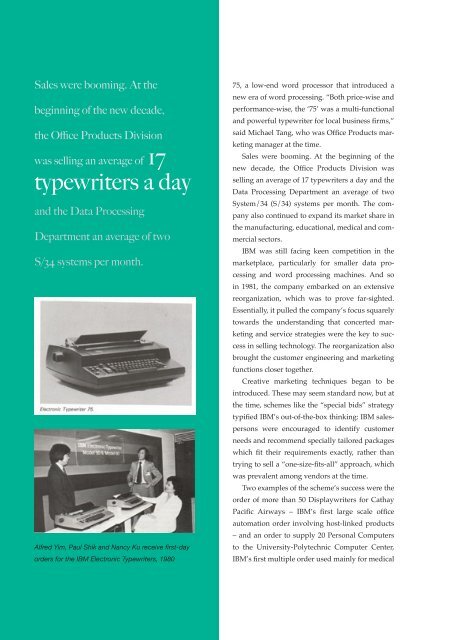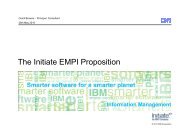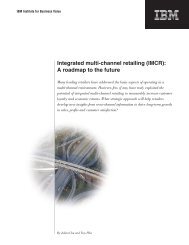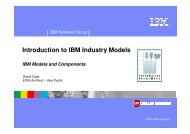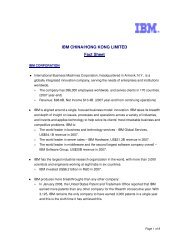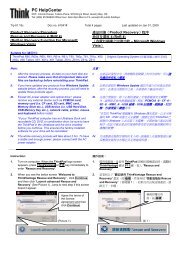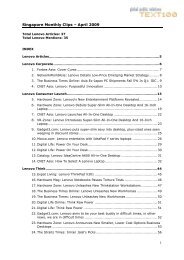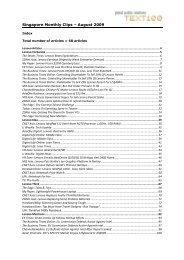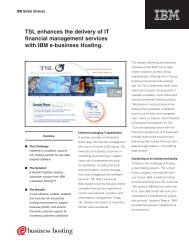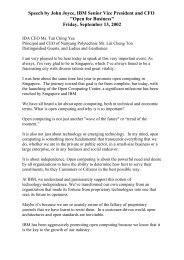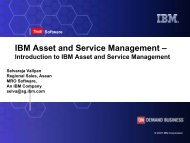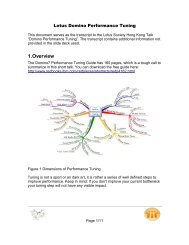THe IBM way
THe IBM way
THe IBM way
You also want an ePaper? Increase the reach of your titles
YUMPU automatically turns print PDFs into web optimized ePapers that Google loves.
Sales were booming. at the<br />
beginning of the new decade,<br />
the office Products division<br />
was selling an average of 17<br />
typewriters a day<br />
and the data Processing<br />
department an average of two<br />
S/34 systems per month.<br />
Alfred Yim, Paul Shik and Nancy Ku receive first-day<br />
orders for the <strong>IBM</strong> Electronic Typewriters, 1980<br />
4 6 • t h E i b m w a y<br />
75, a low-end word processor that introduced a<br />
new era of word processing. “Both price-wise and<br />
performance-wise, the ‘75’ was a multi-functional<br />
and powerful typewriter for local business firms,”<br />
said Michael Tang, who was Office Products mar-<br />
keting manager at the time.<br />
Sales were booming. At the beginning of the<br />
new decade, the Office Products Division was<br />
selling an average of 17 typewriters a day and the<br />
Data Processing Department an average of two<br />
System/34 (S/34) systems per month. The com-<br />
pany also continued to expand its market share in<br />
the manufacturing, educational, medical and com-<br />
mercial sectors.<br />
<strong>IBM</strong> was still facing keen competition in the<br />
marketplace, particularly for smaller data pro-<br />
cessing and word processing machines. And so<br />
in 1981, the company embarked on an extensive<br />
reorganization, which was to prove far-sighted.<br />
Essentially, it pulled the company’s focus squarely<br />
towards the understanding that concerted mar-<br />
keting and service strategies were the key to suc-<br />
cess in selling technology. The reorganization also<br />
brought the customer engineering and marketing<br />
functions closer together.<br />
Creative marketing techniques began to be<br />
introduced. These may seem standard now, but at<br />
the time, schemes like the “special bids” strategy<br />
typified <strong>IBM</strong>’s out-of-the-box thinking: <strong>IBM</strong> sales-<br />
persons were encouraged to identify customer<br />
needs and recommend specially tailored packages<br />
which fit their requirements exactly, rather than<br />
trying to sell a “one-size-fits-all” approach, which<br />
was prevalent among vendors at the time.<br />
Two examples of the scheme’s success were the<br />
order of more than 50 Displaywriters for Cathay<br />
Pacific Air<strong>way</strong>s – <strong>IBM</strong>’s first large scale office<br />
automation order involving host-linked products<br />
– and an order to supply 20 Personal Computers<br />
to the University-Polytechnic Computer Center,<br />
<strong>IBM</strong>’s first multiple order used mainly for medical


